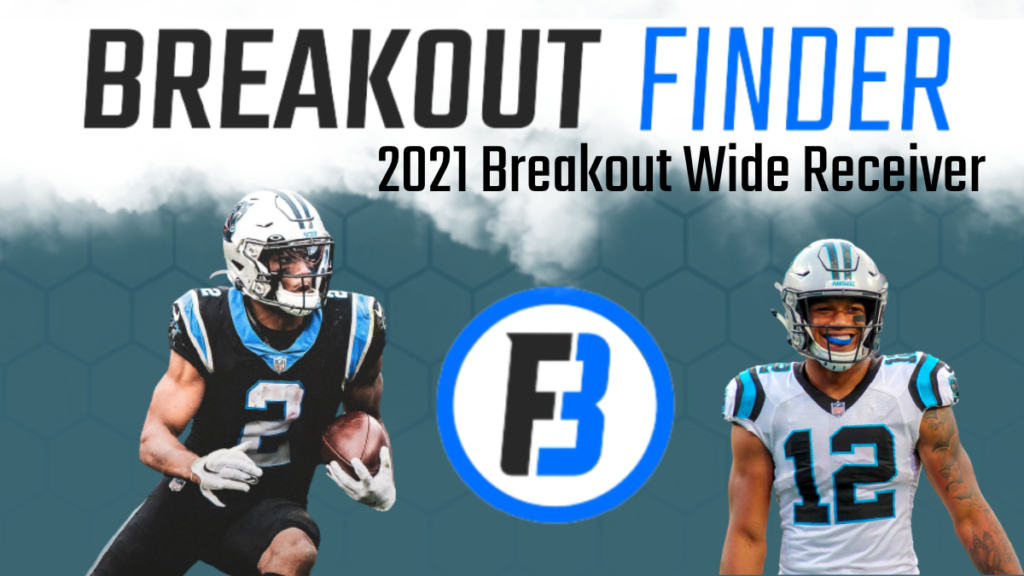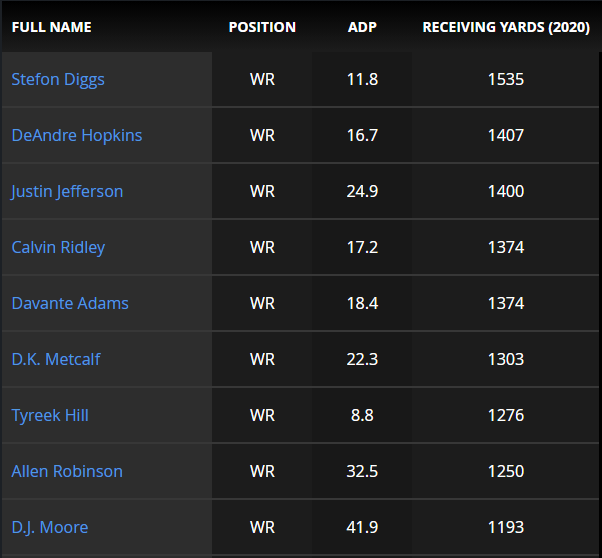
D.J. Moore finished outside the top-12 wide receivers with a 15.4 (No. 14 among qualified wide receivers) Fantasy Points Per Game average in 2019. He was drafted in the top-12 at his position in 2020. People that drafted him in the third round in redraft leagues were disappointed in their return on investment. Based on expectations, he was a bust in 2020.
However, the numbers don’t lie. Most of what Moore was able to do in 2020 was excellent, but key factors prevented him from achieving what he was on the verge of in 2019: a breakout top-12 WR season. Similar to Miles Sanders, Moore’s lack of a breakout last season was due to poor luck that can be turned around in 2021. Calvin Ridley, a fellow wide receiver from the 2018 NFL Draft, broke out last season. The 2021 campaign will see Moore become this year’s breakout wide receiver.
OPPORTUNITY
In 2020, all wide receivers that finished in the top-12 in Air Yards Per Game and top-20 in targets per game finished in the top-16 in Fantasy Points Per Game. Well, except for one wide receiver: D.J. Moore. He averaged 14.1 (No. 27) Fantasy Points Per Game, despite 1,575 (No. 5) Air Yards, a 41.6-percent (No. 2) Air Yards Share, and 118 (No. 19) targets.
Moore saw an 89.6-percent (No. 19) Snap Share and had 525 (No. 21) Routes Run. On top of that, he was near the top of the NFL with 26 (No. 6) Deep Targets. So what was lacking in his opportunity metrics?
Unfortunately, Moore’s quarterback last season, Teddy Bridgewater, struggled in the red zone. On 55 (No. 22) red zone attempts, he finished with a 56.4-percent (No. 38) Red Zone Completion Percentage. As a result, Moore’s 17.0-percent (No. 51) Red Zone Target Share and measly two receptions in the red zone stood out in his opportunity metrics. Having a 23.2-percent (No. 20) Red Zone Target Share in 2019 suggests 2020 was an outlier year in his red zone usage.
PRODUCTIVITY
D.J. Moore has never been a wide receiver to score touchdowns at a high pace. He’s only scored 10 in his career, but touchdowns are not a stat that translates from year-to-year. For example, Cooper Kupp went from nine (No. 2) touchdowns in 2019 to three (No. 65) in 2020. Michael Thomas went from nine (No. 2) touchdowns in 2019 to zero in seven games in 2020. However, Air Yards and targets do translate because they are dependent on a wide receiver’s skill level.

Speaking of Air Yards, despite finishing with 1193 (No. 9) receiving yards, Moore also finished with 757 (No. 8) Unrealized Air Yards, leaving him with plenty of production to add in 2021. With an Underdog ADP of 41.1 (WR19), Moore is being drafted at his floor in fantasy football. All eight WRs that finished with more receiving yards than Moore have top-13 WR ADPs on Underdog.
EFFICIENCY
Last season, D.J. Moore averaged 2.27 (No. 12) Yards Per Route Run, which is a favorite advanced stat of mine. There is a correlation between wide receivers that have high Yards Per Route Run averages and their Fantasy Points Per Game. There were 28 wide receivers last season who finished with 2.00 Yards Per Route Run or more. 13 of the top-16 wide receivers in Fantasy Points Per Game were in that group of 28 wide receivers.
Moore finished top-10 in both yards per reception (18.1) and yards per target (10.1), but struggled with Teddy Bridgewater’s inability to get the ball to him accurately and drops. Only 87 targets were deemed catchable, which comes out to a 73.7-percent (No. 77) Catchable Target Rate. His 10 (No. 2) drops and 8.5-percent (No. 7) Drop Rate, contributed to his 75.9-percent (No. 94) True Catch Rate.
Let’s address the drops. They were problematic, but like touchdowns, it is not a stat that translates from year-to-year. In 2019, Moore finished with a 2.2-percent (No. 94) Drop Rate while peppered with 135 (No. 10) targets that season. The most important takeaway from his drops in 2020 is that his opportunity remained unaffected. His 24.1-percent (No. 18) Target Share in 2020 mirrored his 24.3-percent (No. 17) in 2019.
Moore is on the Allen Robinson career trajectory where he plays with bad quarterbacks incapable of delivering him the ball accurately. In 2019, his 87.9-percent True Catch Rate finished in the top-20, while he finished with a 6.72 (No. 72) Target Accuracy rating. The trend continued in 2020, where Moore finished with a 6.89 (No. 83) Target Accuracy mark.
Like Robinson, Moore is talented enough to overcome lackluster quarterback play and his talent is evidenced by his +68.7 (No. 11) Expected Points Added. According to the Terms Glossary on PlayerProfiler.com, EPA “measures the value of individual plays.” In its simplicity, it’s an advanced stat to help quantify players that help their teams win. Moore joined excellent company in 2020 because nine of the top-12 wide receivers in EPA finished top-12 in Fantasy Points Per Game.
RECAP
D.J. Moore displayed true alpha-WR metrics, such as top-10 finishes in Air Yards and Air Yards Share while averaging 8.0 targets per game. His drops were a hindrance in 2020, but did not affect his top-20 Target Share.
With 1,193 (No. 9) receiving yards in 2020 and another 757 (No. 8) in Unrealized Air Yards, Moore has the potential to see his receiving yardage improve simply by his 8.5-percent (No. 7) Drop Rate returning closer to his 2.4-percent (No. 100) and 2.2-percent (No. 94) marks in 2018 and 2019, respectively.


